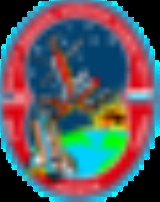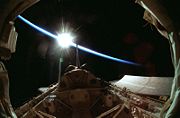
STS-90
Encyclopedia
Backup crew
Mission parameters
- MassMassMass can be defined as a quantitive measure of the resistance an object has to change in its velocity.In physics, mass commonly refers to any of the following three properties of matter, which have been shown experimentally to be equivalent:...
:- Orbiter landing with payload: 105462 kilograms (232,503.9 lb)
- Payload: 10788 kilograms (23,783.5 lb)
- PerigeePerigeePerigee is the point at which an object makes its closest approach to the Earth.. Often the term is used in a broader sense to define the point in an orbit where the orbiting body is closest to the body it orbits. The opposite is the apogee, the farthest or highest point.The Greek prefix "peri"...
: 247 kilometres (153.5 mi) - Apogee: 274 kilometres (170.3 mi)
- InclinationInclinationInclination in general is the angle between a reference plane and another plane or axis of direction.-Orbits:The inclination is one of the six orbital parameters describing the shape and orientation of a celestial orbit...
: 39.0° - PeriodOrbital periodThe orbital period is the time taken for a given object to make one complete orbit about another object.When mentioned without further qualification in astronomy this refers to the sidereal period of an astronomical object, which is calculated with respect to the stars.There are several kinds of...
: 89.7 min
Mission highlights
Neurolab is a SpacelabSpacelab
Spacelab was a reusable laboratory used on certain spaceflights flown by the Space Shuttle. The laboratory consisted of multiple components, including a pressurized module, an unpressurized carrier and other related hardware housed in the Shuttle's cargo bay...
module mission focusing on the effects of microgravity on the nervous system. The goals of Neurolab are to study basic research questions and to increase the understanding of the mechanisms responsible for neurological and behavioral changes in space. Specifically, experiments will study the adaptation of the vestibular system and space adaptation syndrome, the adaptation of the central nervous system and the pathways which control the ability to sense location in the absence of gravity, and the effect of microgravity on a developing nervous system.
The mission is a joint venture of six space agencies and seven U.S. research agencies. Investigator teams from nine countries will conduct 31 studies in the microgravity environment of space. Other agencies participating in this mission include six institutes of the National Institutes of Health
National Institutes of Health
The National Institutes of Health are an agency of the United States Department of Health and Human Services and are the primary agency of the United States government responsible for biomedical and health-related research. Its science and engineering counterpart is the National Science Foundation...
, the National Science Foundation
National Science Foundation
The National Science Foundation is a United States government agency that supports fundamental research and education in all the non-medical fields of science and engineering. Its medical counterpart is the National Institutes of Health...
, and the Office of Naval Research
Office of Naval Research
The Office of Naval Research , headquartered in Arlington, Virginia , is the office within the United States Department of the Navy that coordinates, executes, and promotes the science and technology programs of the U.S...
, as well as the space agencies of Canada, France, Germany, and Japan, and the European Space Agency
European Space Agency
The European Space Agency , established in 1975, is an intergovernmental organisation dedicated to the exploration of space, currently with 18 member states...
.

International Space Station
The International Space Station is a habitable, artificial satellite in low Earth orbit. The ISS follows the Salyut, Almaz, Cosmos, Skylab, and Mir space stations, as the 11th space station launched, not including the Genesis I and II prototypes...
.
Research conducted as planned, with the exception of the Mammalian Development Team, which had to reprioritize science activities because of the unexpected high mortality rate of neonatal rats on board.
Other payloads included the Shuttle Vibration Forces experiment, the Bioreactor Demonstration System-04, and three Get-Away Special (GAS) canister investigations.
STS-90 was the first mission to make an Orbital Maneuvering System (OMS) assist burn during the ascent.
Three sevenths of the STS-90 crew (Williams, Pawelczyk and Buckey) appeared on the Canadian television series Popular Mechanics for Kids
Popular Mechanics for Kids
Popular Mechanics for Kids was a Canadian children's television series based on Popular Mechanics magazine. It was notable for starting the careers of both Elisha Cuthbert and Jay Baruchel. The show's purpose was to teach children how things work...
.
Working with engineers on the ground a week into the flight, the on-orbit crew used aluminum tape to bypass a suspect valve in the Regenerative Carbon Dioxide Removal System that had threatened to cut short the mission.
Mission Management Team considered, but decided against, extending the mission one day because the science community indicated an extended flight was not necessary and weather conditions were expected to deteriorate after planned landing on Sunday, 3 May.
STS-90 Mission Specialist Kathryn Hire was Kennedy Space Center’s first employee to be chosen as an astronaut candidate.
STS-90 also marked Columbia's last daytime landing. Columbia's two last successful flights, STS-93 and STS-109, both had night landings.
STS-90 is the first shuttle flight known to carry a bat on the solid booster. A bat suffered a similar fate during STS-119
STS-119
-Crew notes:This mission was originally scheduled to bring the Expedition 9 crew to the ISS. This crew would have consisted of:-Mission parameters:* Mass:* Orbiter liftoff: * Orbiter landing: * Perigee: * Apogee:...
.
See also
- Space scienceSpace scienceThe term space science may mean:* The study of issues specifically related to space travel and space exploration, including space medicine.* Science performed in outer space ....
- Space shuttleSpace ShuttleThe Space Shuttle was a manned orbital rocket and spacecraft system operated by NASA on 135 missions from 1981 to 2011. The system combined rocket launch, orbital spacecraft, and re-entry spaceplane with modular add-ons...
- List of space shuttle missions
- List of human spaceflights chronologically

